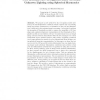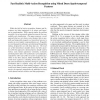510 search results - page 30 / 102 » Invariant Features from Interest Point Groups |
ECCV
2004
Springer
14 years 28 days ago
2004
Springer
Abstract. We propose a new method for face recognition under arbitrary pose and illumination conditions, which requires only one training image per subject. Furthermore, no limitat...
PR
2008
13 years 7 months ago
2008
Our goal is to design algorithms that give a linearity measure for planar point sets. There is no explicit discussion on linearity in literature, although some existing shape meas...
FGR
1996
IEEE
13 years 11 months ago
1996
IEEE
An approach for estimating 3D head orientation in a monocular image sequence is proposed. The approach employs recently developed image-based parameterized tracking for face and f...
CVPR
2009
IEEE
15 years 2 months ago
2009
IEEE
All surfaces can be classified by the conformal equivalence
relation. Conformal invariants, which are shape indices
that can be defined intrinsically on a surface, may
be used t...
ICCV
2009
IEEE
13 years 5 months ago
2009
IEEE
Within the field of action recognition, features and descriptors are often engineered to be sparse and invariant to transformation. While sparsity makes the problem tractable, it ...


